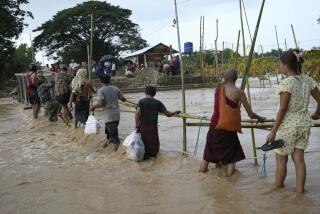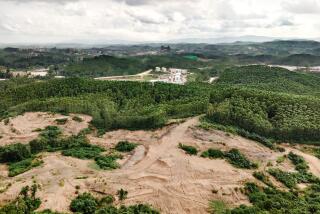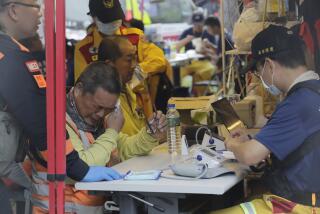Hundreds trapped in Indonesia quake rubble; more than 520 dead
NEW DELHI AND PADANG, INDONESIA — Hundreds of people remained trapped in collapsed buildings Thursday after two powerful earthquakes struck near Padang on the Indonesian island of Sumatra, killing at least 777 people.
The toll was expected to rise. U.N. humanitarian chief John Holmes put the figure at 1,100 and Indonesian Health Minister Siti Fadilah Supari said it could soar into the thousands.
“Let’s be prepared for the worst,” Indonesian President Susilo Bambang Yudhoyono said in the capital, Jakarta, before boarding a flight for Padang. “Let’s not underestimate.”
The latest government death toll was provided to the Associated Press by an Indonesian official who requested anonymity because he was not authorized to give information to journalists.
Thursday morning’s magnitude 6.6 earthquake came on the heels of a magnitude 7.6 quake Wednesday evening that left the city of 900,000 reeling.
“We are overwhelmed with victims and . . . lack of clean water, electricity and telecommunications,” Padang Mayor Fauzi Bahar said on Elshinta radio. “We call on people to come to Padang to evacuate bodies and help the injured.”
“I was shocked,” said Sarah Vaniachavvah, 21, a college student, who was at home when the first quake hit.
Like many, she initially feared a tsunami and fled to higher ground.
“All the buildings started falling down. It was total destruction,” she said. “Now everyone just wants to get away from here as soon as possible.”
Desperate residents dug with their bare hands in hopes of freeing loved ones from flattened buildings. Streets were filled early today with screeching ambulances, funeral processions and dazed people. Gas stations were mobbed.
In front of an English-language school that had been in session when the disaster struck, distraught parents waited behind a barricade, hoping for good news, as a backhoe tried to move aside giant blocks of concrete and other pieces of wreckage.
A diplomat at the U.S. Embassy said officials were searching for missing Americans, but did not say how many were unaccounted for.
Amid the scenes of major destruction, some buildings seemed to be largely untouched. There was no immediate evidence of looting.
Health Minister Supari told the local station Metro TV, “This is a high-scale disaster,” and officials appealed for heavy equipment to help free the buried.
At least 500 buildings in Padang, the capital of West Sumatra province, collapsed in the quakes, according to National Disaster Management Agency spokesman Priyadi Kardono. Among those were mosques, hospitals and a shopping mall. An additional 1,100 buildings were reportedly damaged in the town of Jambi.
Rescue crews struggled to reach at least 80 people staying at downtown Padang’s five-story Ambacang Hotel.
At least 440 people were seriously injured in the quakes, according to a crisis center set up by the Social Affairs Ministry.
In the streets, people set up makeshift shelters for survivors and relatives of the missing.
A Singapore man, John Lee, was pulled from beneath the Mariani International hotel 25 hours after it collapsed. Rescue workers, responding to his cries for help, dug for 12 hours to free him.
At the Padang airport, tourists with surfboards waited to board outbound flights. Nearby, a Swiss emergency medical aircraft waited on the tarmac.
The Indonesian navy planned to dispatch six warships with supplies to the area today, the Jakarta Post reported, including a vessel with 50 doctors and medical experts that is expected to serve as a mobile hospital.
Transport officials asked airlines not to raise ticket prices to Padang amid increased demand as people rush to help relatives. Reports said some domestic fares to the city had nearly doubled.
The U.S. Geological Survey said the quakes were centered along the fault that spawned the Indian Ocean tsunami of December 2004, which killed more than 220,000 people in a dozen countries.
The temblors were also felt in neighboring Malaysia and Singapore.
President Obama, who lived in Indonesia for part of his childhood, offered American aid and expertise.
“I know firsthand that the Indonesian people are strong and resilient and have the spirit to overcome this enormous challenge,” he said at a news conference.
Al Jazeera satellite TV channel reported that Padang’s mayor had asked the central government for funds last year to bolster the city’s evacuation plans in the event of an earthquake but that the request was turned down.
The government Thursday announced $10 million in emergency aid and said medical teams and military planes were being dispatched to set up field hospitals and distribute tents, medicine and food.
One Padang hospital collapsed and another, the state-run Djamil facility, was damaged, and many patients are being treated in tents outside.
Rescue workers, already stretched, were further frustrated by rain, severed communication links and buckled roads that created huge traffic jams.
Most buildings in Indonesia, an impoverished, natural-disaster-prone nation of 235 million, are not built to withstand strong earthquakes.
“What typically happens is that people become terrified to go back into their homes, especially if damaged, as there will be numerous aftershocks,” Jimmy Nadapdap, director of World Vision Indonesia, said on the aid group’s website. “Securing alternative shelter will be critical.”
Burhaydin, 46, a Padang man who uses one name, watched the city’s central market burn in the mayhem. He said Indonesians are nothing if not resilient.
“The city can rebuild,” he said, “so long as there isn’t another earthquake.”
--
McDermid is a special correspondent.
Anshul Rana of The Times’ New Delhi Bureau contributed to this report.
More to Read
Sign up for Essential California
The most important California stories and recommendations in your inbox every morning.
You may occasionally receive promotional content from the Los Angeles Times.










